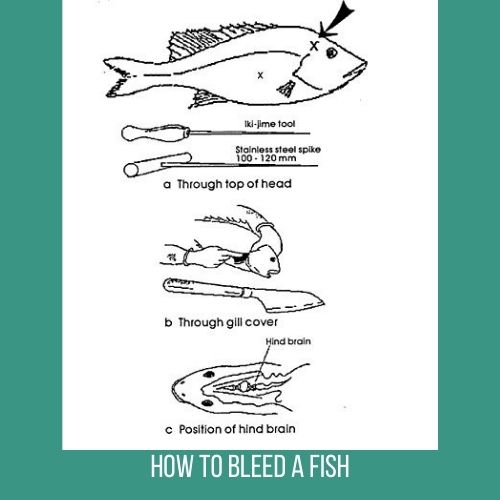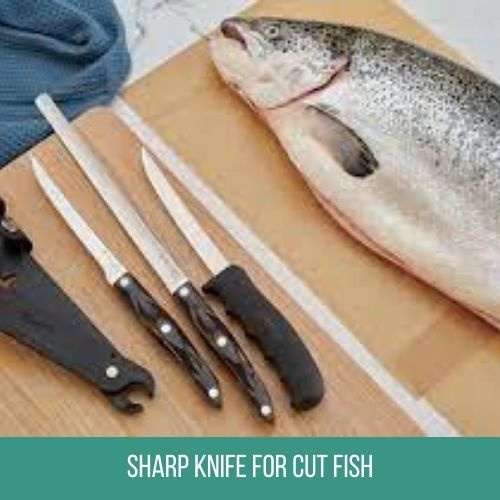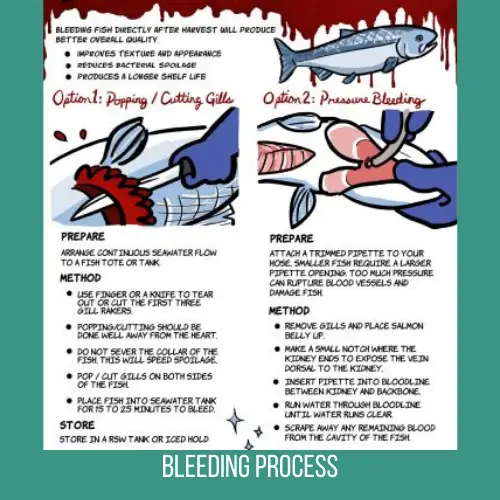Contents
- 1 How To Bleed A Fish:
- 2 Sharp Knife:
- 3 Bleeding Process:
- 4 Cutting Board:
- 5 Ensuring Safety:
- 6 Slitting the Gills:
- 7 FAQs:
- 8 Why is bleeding a fish necessary?
- 9 What tools do I need for bleeding a fish?
- 10 How do I choose a suitable location for bleeding a fish?
- 11 Can I use any knife for bleeding a fish?
- 12 How should I cut when slitting the gills?
- 13 Is there a specific way to dispose of the blood and discarded parts?
- 14 Can bleeding be done on all types of fish?
- 15 How does bleeding affect the fish’s freshness and shelf life?
- 16 Are there alternatives to bleeding for improving fish quality?
- 17 Can I bleed a fish after it has been gutted?
Bleeding a fish is a crucial step in the preparation process after catching it. This method helps enhance the quality and taste of the fish by removing excess blood, which can contribute to a fishy flavor. Proper bleeding also improves the texture of the fish fillet.
In this short guide, we’ll explore the basic steps involved in bleeding a fish to ensure you get the most out of your catch.
How To Bleed A Fish:
The importance of bleeding a fish lies in its significant impact on the final product’s quality, taste, and overall culinary experience. Here are some key reasons why bleeding a fish is essential:

Freshness Preservation: Bleeding a fish promptly after catching it helps remove excess blood from the circulatory system, preventing it from clotting within the fish’s flesh. This, in turn, extends the freshness of the fish and minimizes the risk of off-flavors associated with blood.
Improved Flavor: Blood contains compounds that can contribute to a fishy or metallic taste. By bleeding the fish, these compounds are removed, resulting in a cleaner, milder flavor. This enhances the natural taste of the fish and allows other flavors to shine through during cooking.
Enhanced Texture: Bleeding aids in maintaining the texture of the fish fillet. Coagulated blood can affect the firmness and tenderness of the flesh. Proper bleeding ensures a firmer texture and helps prevent mushiness, resulting in a more appealing and enjoyable eating experience.
Aesthetic Appeal: Bleeding a fish helps maintain the visual appeal of the fillet by preventing discoloration. The removal of blood ensures that the flesh remains vibrant, making the fish more appetizing and visually appealing when presented or prepared for cooking.
Reduced Fishy Odor: Blood contains compounds that can contribute to the characteristic fishy odor. Bleeding the fish minimizes this odor, making the handling and cooking
process more pleasant for those sensitive to strong fish smells.
In summary, bleeding a fish is a crucial step in the post-catch process that directly impacts the overall quality of the seafood. It not only preserves freshness but also enhances flavor, texture, and visual appeal, providing a more enjoyable dining experience for those indulging in the catch.
Sharp Knife:
When bleeding a fish, using a sharp knife is essential for achieving precise and clean cuts. Here’s why a sharp knife is important in this process:

Efficiency in Cutting: A sharp knife cuts through the fish’s gills and blood vessels more efficiently and with less effort. This efficiency is crucial for a quick and effective bleeding process.
Clean Cuts: A sharp knife produces clean and precise cuts, minimizing damage to the surrounding tissues. Clean cuts facilitate better blood drainage and help preserve the overall quality of the fish fillet.
Reduced Stress on the Fish: A sharp knife requires less force to cut, which means less stress on the fish during the bleeding process. This is important for humane handling and ensures minimal harm to the fish before it is prepared for consumption.
Safety: A sharp knife is safer to use than a dull one. Dull knives can slip or require more force, increasing the risk of accidents. A sharp knife, on the other hand, provides better control and reduces the likelihood of injuries during the bleeding process.
Faster Process: With a sharp knife, the bleeding process can be completed more quickly. This is especially important when you want to bleed the fish immediately after catching it, preserving its freshness and ensuring the best possible flavor and texture.
Versatility: A sharp knife is versatile and can be used for various tasks in the preparation process, from bleeding to filleting. This versatility makes it a valuable tool in the overall handling of the catch.
Before bleeding a fish, always ensure that your knife is sharpened and well-maintained. Regularly honing and sharpening your knife will not only make the bleeding process more effective but also contribute to overall kitchen safety and efficiency.
Bleeding Process:
The bleeding process is a crucial step in preparing a freshly caught fish for consumption. To bleed a fish, start by ensuring you have a sharp knife and a clean, safe workspace. Choose a suitable location, ideally near the water, and securely hold the fish. With a swift and precise motion, make a incision across the gills, severing the major blood vessels.
Allow the blood to drain completely by holding the fish over a container or into the water. This step is vital for removing excess blood, which can contribute to off-flavors and affect the texture of the fish. Proper bleeding not only enhances the overall taste and freshness of the fish but also improves its visual appeal.
Additionally, bleeding minimizes stress on the fish and ensures a humane and efficient processing method, contributing to a more enjoyable culinary experience.

Cutting Board:
Choosing the right cutting board is an essential aspect of the fish bleeding process. Opting for a high-quality cutting board provides a stable and sanitary surface for the task at hand. A durable cutting board, preferably made of materials like plastic or wood, ensures that the knife cuts cleanly without damaging the blade or the fish.
The cutting board should be large enough to accommodate the size of the fish and have a non-slip surface to prevent accidents during the bleeding process. Additionally, using a designated cutting board for seafood helps prevent cross-contamination with other foods.
Proper cleaning and sanitization of the cutting board after each use are imperative to maintain hygiene standards. Overall, a well-chosen cutting board complements the sharp knife, creating an efficient and safe environment for bleeding the fish and subsequent preparation steps.
Ensuring Safety:
Ensuring safety during the fish bleeding process is paramount to a smooth and secure operation. Start by choosing a stable and flat surface for the task, such as a sturdy table or a cleaning station near the water. Prioritize a non-slip cutting board to prevent accidents and maintain control over the fish and the knife.
Wear protective gloves to safeguard against any potential injuries and to maintain hygiene. When making incisions, be mindful of your fingers and hand placement, ensuring that they are away from the knife’s path. Use a sharp knife to minimize the force required for cutting, reducing the risk of slips.
Properly dispose of any discarded parts to avoid creating hazards or attracting unwanted wildlife. If working near water, be cautious of slippery surfaces and potential uneven terrain. Lastly, always follow best practices for knife safety, such as keeping the blade pointed away from yourself and others.
Prioritizing safety measures ensures a smooth and risk-free fish bleeding process, contributing to a successful and enjoyable fishing experience.
Slitting the Gills:
When slitting the gills during the fish bleeding process, precision and care are key. Begin by placing the fish on a secure cutting board with its head extending slightly over the edge. Grasp the fish firmly to prevent unnecessary movement.
Using a sharp knife, make a swift and decisive incision just behind the gill covers, cutting through the membranes and major blood vessels. Ensure the cut is enough to allow efficient blood drainage. Applying a slight angle to the knife can facilitate a cleaner and more effective cut.
Take care not to damage the surrounding flesh or other vital structures. As the incision is made, blood will begin to flow out of the gills, indicating the successful initiation of the bleeding process.
Be mindful of safety precautions, keep your fingers clear of the knife’s path, and maintain control over the fish throughout this critical step. Properly executed, slitting the gills sets the stage for improved flavor, texture, and overall quality of the fish.
Conclusion:
In conclusion, bleeding a fish is a fundamental and impactful step in the preparation process that significantly influences the quality of the final product. By using a sharp knife and a suitable cutting board, the bleeding process can be carried out efficiently and safely.
Choosing a stable workspace, wearing protective gear, and being mindful of safety measures are crucial aspects of ensuring a smooth and secure operation. Slitting the gills with precision allows for effective blood drainage, promoting freshness and enhancing the flavor and texture of the fish fillet.
The benefits of bleeding extend beyond the culinary aspect, contributing to humane handling practices and a more enjoyable overall dining experience. Emphasizing these practices creates a foundation for maximizing the quality and appeal of the catch, from the moment it is pulled from the water to the culinary delight it becomes on the plate.
FAQs:
Why is bleeding a fish necessary?
Bleeding a fish is essential to remove excess blood, which can contribute to off-flavors and affect the texture of the fish. It enhances the overall taste, freshness, and quality of the fish.
What tools do I need for bleeding a fish?
The essential tools include a sharp knife for precise cuts, a suitable cutting board, and a container for blood drainage.
How do I choose a suitable location for bleeding a fish?
Ideally, choose a location near the water for easy cleanup. Ensure a stable and flat surface, and be cautious of slippery areas, especially if working near the shore.
Can I use any knife for bleeding a fish?
It is recommended to use a sharp knife with a pointed tip for clean and efficient cuts. Dull knives may require more force, increasing the risk of accidents.
How should I cut when slitting the gills?
Make a swift incision just behind the gill covers, ensuring that you cut through the membranes and major blood vessels for efficient blood drainage.
Is there a specific way to dispose of the blood and discarded parts?
It is advisable to dispose of blood and fish parts responsibly, considering the environmental impact. Check local regulations for proper disposal methods.
Can bleeding be done on all types of fish?
Bleeding is generally recommended for most fish species. However, specific methods may vary based on the type of fish and personal preferences.
How does bleeding affect the fish’s freshness and shelf life?
Bleeding helps preserve the freshness of the fish by removing blood, which can accelerate spoilage. Proper bleeding contributes to a longer shelf life and maintains the quality of the catch.
Are there alternatives to bleeding for improving fish quality?
While bleeding is a common practice, other methods like icing or gutting the fish promptly can also contribute to preserving freshness and quality, but bleeding remains a widely recognized technique.
Can I bleed a fish after it has been gutted?
While bleeding is most effective when done immediately after catching, it can still be beneficial to bleed a fish after gutting if it was not done initially. However, bleeding shortly after catching is preferable for optimal results.








